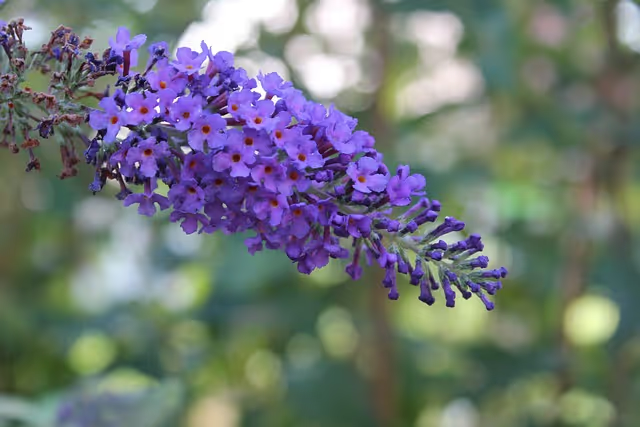Butterfly Bush


This week is National Invasive Species Awareness Week, so let’s take a look at one of the WA Invasive Species Council’s priority species: butterfly bush.
Butterfly bush (Buddleja davidii) is a woody, deciduous perennial shrub native to China. It can grow up to 15 feet in height and has arching branches. The leaves are lance-shaped with toothed edges and can grow up between 4-10 inches long. The upper side of the leaves are green or bluish in color while the undersides are whitish and hairy. The flowers grow in fragrant, cone-shaped clusters between 4 to 10 inches in length. The flowers are usually purple with orange centers, but can be a wide variety, including but not limited to pink, blue, orange, and white. They bloom between July and September.
The plant reproduces by seed and it can produce a lot of them—up to 40,000 per flower head. The seeds are small and winged, allowing them to be easily dispersed by wind and water. The seeds remain viable for 3-5 years. If branches are cut from the plant and left on the ground, they are capable of growing roots and becoming a new plant.
Butterfly bush thrives in areas with well-drained soil and full sun, but can tolerate drought and poor soil conditions. They can colonize disturbed areas, such as roadsides, cleared forests, or pastures, as well as riparian areas. They form dense thickets that can displace native plants. This is especially problematic on riverbanks, as they can displace native trees such as willow, cottonwood, and cedar. These trees provide shade for the river, which is vital to healthy salmon habitat (NW Treaty Tribes).
Butterfly bush is a Class B noxious weed in Washington, which means it widespread in some areas but not others. As such, whether eradication is required or not is decided at the local level. In Grays Harbor County, preventing the spread of butterfly bush is not required (GH 2023 Noxious Weed List). It is on the quarantine list for Washington State and therefore it is illegal to buy or sell butterfly bush unless they are of a sterile cultivar, which produce less than 2% viable seed (WA Noxious Weed Control Board).
To prevent butterfly bush from spreading, remove the flowers before they have the chance to seed. Young plants can be dug up and removed while more established plants can be treated by cutting the plant to the stump and applying herbicide. Properly dispose of all flower and stem cuttings to prevent them from spreading.
References
Butterfly Bush. Washington Invasive Species Council. (2019, October 25). Retrieved February 21, 2023, from https://invasivespecies.wa.gov/priorityspecies/butterfly-bush/
Butterfly Bush. Washington State Noxious Weed Control Board. (n.d.). Retrieved February 21, 2023, from https://www.nwcb.wa.gov/weeds/butterfly-bush
Butterfly Bush. Washington State University Extension Whitman County. (2013). Retrieved February 21, 2023, from https://extension.wsu.edu/whitman/2013/11/butterfly-bush/
Grays Harbor County Noxious Weed. (2023). Grays Harbor County 2023 Noxious Weed List. Elma, WA.
Jamestown S'klallam, partners remove butterfly bush from Dungeness River. Northwest Treaty Tribes. (2015, September 29). Retrieved February 21, 2023, from https://nwtreatytribes.org/jamestown-sklallam-partners-remove-butterfly-bush-from-dungeness-river/
Tribe fighting latest trend in noxious weeds: Butterfly Bush. Indian Country Today. (2018). Retrieved February 21, 2023, from https://ictnews.org/archive/tribe-fighting-latest-trend-in-noxious-weeds-butterfly-bush
© Laura Caldwell, February 2023
Touch whale bones, examine shipwreck artifacts and connect with the coast's living history.

Support our mission, get involved in educational programs, or contribute through donations and volunteering.